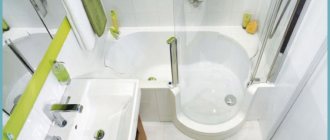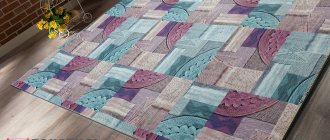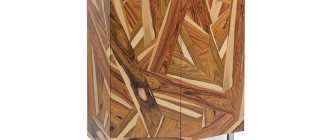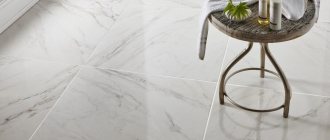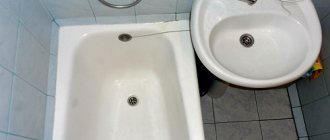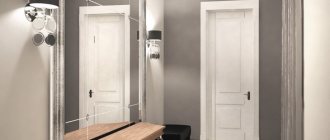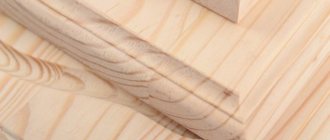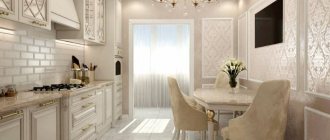Mosaic canvas
Mosaics have a centuries-old practice ranging from hand-made to mass-produced in a large variety using different techniques and effects.
Mosaics are small squares with a side of 10x10 mm, 20x20 mm, 50x50 mm, which are laid in dense rows, one next to the other, and create real works of art on the walls.
Advantages of finishing material “mosaic”
Mosaic tiles in the interior are readily used by both designers and builders, as they have a number of excellent qualities that meet the criteria for surface finishing:
- First of all, the material allows you to create interesting, original compositions on the wall, highlight the advantages of the room, and create a luxurious, cozy atmosphere;
- Environmentally friendly finishing material. In production, only natural ingredients are used that are odorless and do not emit toxic substances. Successfully used in kitchens, bathrooms, and living spaces;
- Moisture resistance. The ceramics are covered with a glaze that prevents the seepage and absorption of moisture, which allows the mosaic to be used in rooms with high humidity and places that require frequent cleaning to remove scale, gnawing, and splashes;
- Clay undergoes a hardening process at the production stage, as a result, ceramic tiles can withstand temperature changes and are resistant to low and high temperatures. Finishing in baths, saunas, swimming pools is allowed;
- Fire resistance, heat resistance;
- The small size of the material makes it possible to cover surfaces of any curves and shapes, including finishing columns, curved lines of bathtubs, bar counters and cabinets;
- The ability to decorate rooms in accordance with the design, organically combining various materials and creating an interesting, individual interior;
- Simplicity and ease of installation. The material is attached to any surface, plastered, wooden, metal, pre-prepared. Combines well with other decorative and finishing materials;
- The mosaic tile catalog presents a huge selection of colors, textures and shapes for surface design.
Mosaic in the interior
A couple of hundred centuries ago, when such a variety of decorative elements in the interior, as well as such concepts, did not exist, the walls of rich houses of noble people were decorated with bizarre and intricate shapes, consisting of many small squares, together creating real canvases. Today this approach is still used, especially when it comes to kitchens and bathrooms. Thus, mosaic in the interior has become the choice of those who, on the one hand, do not depart from the classics, but on the other, prefer to be original.
Kitchen mosaic
The so-called kitchen apron - the work area in the kitchen - becomes a place where neatly laid out small glass squares immediately attract the eye. Mosaic in the interior of the kitchen is the main detail that becomes the hallmark of the room.
Thanks to the wide variety of colors and materials, you can invent and create both real panels, and, being conservative in your preferences, make a choice in favor of abstraction and patterned designs. In addition to its obvious external properties, the interior of a kitchen with mosaics will delight you with its functionality. First of all, we are talking about the features of a material that is wear-resistant and resistant to mechanical damage. Also worthy of attention is the fact that the seams at the joints, unlike tiles, are not visible, and the need for grouting them disappears by itself.
Types of mosaics
Today, having decided to decorate your interior in such a rich and elegant way, it is important to first decide on the material, which in turn can be:
- glass;
- mirrored;
- ceramic;
- stone.
While the last option can be classified as rare, all the others quite often become harmonious solutions for the premises of a house or apartment.
Glass mosaic in the interior can be different in shape and endless in color. Squares, rectangles, diamonds, triangles, matte and glossy shades of the entire diverse palette allow you to come up with interesting combinations. Glass is also a fairly strong and therefore durable material that can remain the main decoration of a room for many years.
As for mirror mosaic in the interior, it can well serve as a decorative decoration, for example, for a bar counter, table top, or become an excellent replacement for traditional glass in a door.
Finally, ceramic mosaics in the interior will create a unique look for walls and floors, and thanks to the existing options for effects (stylized cracks and coatings of different shapes), preserving the individuality and exclusivity of the room will not be difficult.
Mosaic is appropriate in any room
Thinking about the design of a bathroom and reviewing an endless number of catalogs, the owner of a house or apartment often opts for mosaics, which somehow especially builds up the space. The interior of a bathroom with mosaics can be done either completely or partially. However, it is important to take into account that in the case of an absolute mosaic laying of the walls and floor, the cost of the work will be very impressive, and it is important not to make a mistake when choosing a master who knows how to professionally lay out the entire perimeter. That is why, wanting to save money, many owners of their homes prefer either an option combined with tiles, or a partial installation of certain patterns related to the marine theme.
The bathroom and kitchen are far from the only rooms that are ready to happily accept this original technique. Thus, mosaic in the interior of the living room can exist in individual details and pieces of furniture - a fireplace, window sill or coffee table. It is perfect for updating and starting a new life for old, vintage things - vases, boxes, watches. The mosaic in the interior of the hallway looks no less interesting. Present in the lining of a chest of drawers, decorating the borders of a door arch or simply decorating a wall with an independent panel, this technique, which has stood the test of time for centuries, continues to remain relevant to this day.
Glossy
It is distinguished by a shiny surface covered with a transparent glaze; it is used mainly for wall decoration, as it creates a strong sliding effect on the floor. Cleans well and can be wet cleaned.
Glass, smalt
Pieces of painted glass or ordinary transparent glass, applied in a drop on a textured base. The manufacturing process is reminiscent of the production of high-quality Venetian glass and bears the same name. Smalt in the interior creates a beautiful visual pattern and glare of light on surfaces.
Made in different colors, it allows you to create a variety of images, including photographs and artistic paintings. Used as mosaic tiles for the kitchen.
What is modern mosaic made from?
Yes, about 30 years ago, there was not such a variety and availability of materials as now, but still more than a couple of thousand years ago. Interesting? Well, then let's go!
Interesting? Well, then let's go!
So, for some I may now be discovering “America,” while others are already aware of all this. But for some reason I wanted to write about mosaic as a material, since I myself have been working in this field for more than 14 years...
I will not delve into the history of mosaic art; there is a lot of this information on the Internet, moreover, almost a third of my diploma is devoted to this very thing. If anyone is still interested, I will write a separate article.
Nowadays, when handicrafts, handicrafts and everything done by hand using simple tools have begun to be valued and have become fashionable to some extent, many are mastering various handicraft techniques, mixing different materials and technologies. It seems strange in the age of high technology, but no! Our entire reality is dual, technologies are developing - as opposed to handicrafts.
Today, all materials used in work can be divided into 5 types:
- glass;
- ceramics;
- stone;
- metal;
- natural materials (organic).
Now about each in more detail with pictures.
Glass, or glass mosaic, is essentially an artificial material produced by man, and it has one feature. This is the most commonly used type since man learned to make it. This includes smalt , the production technology and composition of which have remained almost unchanged since its invention, and this is the 2nd-1st century BC.
Industrially produced glass mosaic First, it is cooked like soup from various components (raw materials), and then cells (circles, triangles and other geometric shapes) are obtained from this mass by stamping.
Stained glass. Glass production is similar to mosaic production at the “soup” stage, but then everything is a little different. The glass is pulled like a belt on a metal conveyor, constantly heated so that it does not lose its plasticity, this produces such a long endless glass “rag”. Then this still warm “rag” is carefully cut and the next piece is pulled out. After cooling, the frozen sheets of glass are carefully cut into even smaller pieces and sent for packaging. And the mosaic is already made from scraps that will not go into stained glass due to the smallness of the pieces.
Glass darts (colored, non-hollow glass rods) are better known to lampworkers. The dart is produced industrially; the diameter of such a rod can range from 2 mm to 3 cm. Using a dart, glassblowers first form a piece of glass mass on a metal rod, and then blow it out like a ball, vase or any vessel. If desired, you can make a dart yourself from leftovers, glass, smalt using a gas burner. This is what the dart looks like after industrial production. It is always round in cross section!
One very famous Italian company even released an exclusive series of eyeglass frames that used a micromosaic of colored darts welded together.
Beads, beads and glass beads are, in general, glass. You can also make panels and micromosaics from them. You just need to stock up on a magnifying glass, tweezers and patience. But more on that in another topic.
Nowadays it is very fashionable to collect paintings from “diamond mosaic”. I’ll say right away that this type of needlework has nothing to do with diamonds or mosaics. This is the “creation” of paintings using cut acrylic rhinestones. I wouldn't even call it handicraft. Most of all it reminds me of “color by numbers” or putting together a puzzle. Yes, these types of leisure activities themselves have their place. Develops patience and perseverance. But they have nothing to do with creativity, flights of fancy and handicrafts. Forgive me!
Ceramics and porcelain tiles. The materials are related in origin, but there is still a difference. I won’t bog you down in this article with production technology, compositional features and differences in physical properties. If there is interest, I will devote a separate article to this. To simplify in this context: ceramics are anything covered with a colored or colorless glaze and fired. The shape can also be any: square, circle, rhombus.
Porcelain stoneware is uncoated ceramics, but has the same color on the fracture as on the surface; its manufacturing technology is also similar to the production of ceramic tiles and mosaics.
The technology for producing ceramics is even more ancient than that of glass. The age of the shards of ancient vessels dates back to the 18-17th millennium BC. e. It is clear that, first of all, figurines, sculptures and then dishes were made from ceramics. But the dishes broke, shards remained - from these, colored and different in size, the ancient people began to assemble a mosaic. It is clear that the color palette of ceramics is poorer than that of glass - this explains the great popularity of the second to this day! Glass is more durable, it does not lose its properties; color, strength and shine over time. Well, unless, of course, you throw a weight on him. Yes, glass is an eternal material! It is not afraid of frost, fire, water, or wind! You can achieve greater effects in glass than in ceramics. It can be transparent, with streaks of other shades inside, or it can have gold and silver sealed inside. With shimmers of golden sand (aventurine effect). It can imitate natural stone! And another big plus compared to other materials. It can be melted down, any scraps, broken vases and windows, any broken glass, bottles, even glass dust - everything is a raw material for new glass!
But ceramic mosaic has its place! Everyone knows Gaudi Park in Barcelona - entirely ceramic mosaic! So, ceramic mosaic is any tile (broken accidentally or intentionally into small pieces), industrially produced by stamping; cups and saucers made of porcelain, earthenware and majolica are also ceramics and can find their second life in someone’s panel! Ceramics is a heat-loving material and is more widespread in sunny countries (Spain, Turkey, Africa)
Stone . This includes all types of minerals known to us - limestone , marble, onyx, granite, semi-precious stones , even sea pebbles are also stones - ground by the sea and time.
I would also include amber here, although it is a gem of organic origin - frozen and fossilized resin. Everyone remembers the famous amber room; it was created using the Florentine mosaic technique, assembled from saw cuts and pieces of this unique gem!
Metal mosaic. It is clear that non-ferrous and ferrous metals are now expensive, so mosaics made from them are not cheap. Moreover, if a 2 × 2 cm cell were made entirely of metal, it would weigh a lot and be “phonic”. Therefore, in the production of modern metal mosaics industrially, stainless steel, brass, and less often copper are most often used! Moreover, the piece itself consists of 2 layers. The first is the basis. The material for its manufacture can be ceramics or plastic. The front layer is attached to it - a metal plate, like a lid. It is attached to the ceramic base with special glue.
It is clear that such pieces cannot be pricked or cut, but why? Typically, such mosaics are used in high-tech interiors. And there, as a rule, minimalism and austerity reign!
Natural materials or organics . No, no, we will not consider human bones, teeth and nails in this case. I’d rather tell you in more detail about other natural materials. We all love collecting shells on the seashore. They are so beautiful, delicate shades, with mother-of-pearl and shine. Enterprising Asian lovers of collecting shells came up with a technology for flattening these same shells under pressure and heat. And then they cut them into circles, squares, polygons. The thickness of such a mosaic is only 1 mm, the shells are thin, but in terms of strength and fracture resistance they are better than ceramics and glass! Like this! The shades of shells are like the shades of pearls: white, pink, yellowish and black!
If you see bright red, purple and dark brown shades, you should know that this is originally white mother-of-pearl, colored with chemical dyes. The paint saturates all internal cavities and scales, is fixed inside with steam, and such a “painted” mosaic can be washed by pouring water on it. But! Over time, it gradually fades, like wallpaper on which the sun constantly falls! Interiors made from this natural material look very stylish and expensive!
Wooden mosaic! This is truly limitless use material for our country! And most importantly, it is very accessible, because it is literally lying under your feet! And many people use wood, namely cuts of juniper (how it smells), birch, spruce, cherry and many other trees as material for mosaics! Wood can be tinted, coated with shiny or matte varnish.
Coconut , in fact, is also a “tree”, but has a denser structure! The material is beautiful, natural, but specific. Since the nut is always round, it is impossible to make a perfectly even mosaic from walnut; the pieces are always slightly convex. And the color of coconut, unlike wood, is always approximately the same. Only the surface can be matte or polished.
I won’t dwell for long on a mosaic of food, pasta, cereals, legumes, breakfast rings, coffee beans, chips, sausage, sushi, and so on... Still, such a mosaic is not durable! It is more suitable for creativity with children, developing perseverance, and the availability of materials is a big advantage!
And finally, for inspiration, panels made of unusual materials that not everyone would even think of using for this. Get inspired!
Mosaic of nails or screws (metal)
Mosaic of wine corks (wood)
Mosaic of tablets and pills (organic). Symbolic right?
What do you think of the mosaic made from Rubik's cubes?
So create with whatever you want! I wish you creative success!
Using a Grid
Mesh. The parts are attached to a construction mesh that has a flexible structure. Working with such a canvas is convenient and quick, as it resembles the standard sizes of regular and large tiles.
Note!
Wood-look tiles: see here the most successful solutions for using wood-look tiles in different interiors- Tile design - exclusive options and ideas | See the latest and most fashionable solutions here!
- White tiles | The best interior solutions in real interiors and beautiful projects using white tiles
Dimensions and shape of kitchen mosaics
The individual elements that make up the mosaic cladding are called chips or tesserae. Depending on the design, material and manufacturer, their size can vary from 1x1 to 10x10 cm. To decorate an apron in the kitchen, it is best to use mosaics measuring from 2x2 to 5x5 cm.
The most popular shape of mosaic pieces is squares. Rectangles are often found, less often circles, ovals, rhombuses, and hexagons.
In the gallery there are photos of mosaics from Architeza, Fusion Natural Mosaic, Bars Crystal, Colori Viva (China) and Chakmaks (Turkey):
For ease of installation, mosaics are not sold individually, but in the form of so-called matrices: mosaic pieces are glued onto a base made of polyurethane mesh or paper. The standard size of such a matrix is 30x30 cm, but from different manufacturers it may differ by plus or minus a couple of centimeters. For example, make up non-standard 31.5x31.5 or 29.8x29.8 centimeters. Pay special attention to this when calculating the required amount of finishing for the apron.
Mosaic Metall from Natural Mosaic (China)
Ceramic tiles "mosaic"
To facilitate the installation process, mosaic tiles are used. This is an ordinary tile of regular sizes, divided into small squares of the appropriate shape. Such tiles have all the properties of ceramics: fire resistance, wear resistance, hygiene, durability, a wide range and scope of application.
Finishing with mosaic tiles allows you to decorate large flat surfaces, reduce the cost of purchasing material, and protect the surface from dirt, plaque, mold and fungi.
Ceramic mosaic
Both in terms of composition and production method, ceramic mosaic is simply miniature ceramic tiles. Therefore, its properties and features are the same as those of tiles.
It is made from white or red clay, quartz sand and other natural ingredients.
The color variety of ceramics is amazing. It does not fade over time and is not afraid of bright sunlight.
Wear resistance is one of the main advantages of such a mosaic. Thanks to the glaze, it almost does not absorb water and is not afraid of aggressive chemicals.
The surface of ceramics is more prominent and expressive than that of glass. Therefore, an apron made from ceramic mosaic will be more textured than one made from glass.
However, ceramic mosaic tiles are significantly more expensive than their “sister” tiles, and their range and color range are not as rich as those of glass mosaic finishes.
Ceramic mosaics are usually sold in the form of matrices measuring 30x30 centimeters. The size of mosaic pieces can vary from 1x1 to 10x10 centimeters. Their thickness is 8-10 millimeters (twice that of glass mosaic).
The shape of the elements can be different - in addition to traditional squares, you can find tesserae in the form of rectangles, triangles, hexagons, circles, etc. There are also ceramic mosaics that imitate the shape and color of sea pebbles. Matrices with it have uneven edges to ensure a seamless surface.
The surface of mosaic ceramics can be glossy, matte or textured, sometimes imitating natural stone and other finishing materials and having various decorative effects such as craquelure.
Beautiful mosaic inserts, borders and splashback panels can also be found in ceramic tile collections, where they serve as decor. By the way, we recommend reading a detailed guide on choosing kitchen tiles for a backsplash with professional recommendations, installation options and a lot of other useful information on this topic.
Price
On average, from 300 to 900 rubles for a 30x30 cm matrix, depending on the decorativeness and texture of the surface.
Where can I buy
Interesting types of ceramic mosaics can be found in the assortment of Radical Mosaic, LIYA Mosaic (China), FK Mosaic (Turkey), Peronda (Spain), Marca Corona (Italy), Jasba (Germany).
Features of purchasing material
When choosing a mosaic, follow the advice of our experts and the purchase will only bring you pleasure:
- Do not buy ceramic mosaic tiles based on photos from catalogs. Be sure to hold the material in your hands, check the quality of the glaze and the evenness of the joints and seams;
- Construction work begins with the creation of a project, which indicates the amount of material. Tiles should be purchased 10-15% more, since it is not always possible to purchase exactly the same tile;
- The material is chosen based on the overall style of the room, taking into account the color of furniture and accessories;
- It is necessary to determine the area of the surface to be decorated and its bends. Depending on this, choose the size of the mosaic and the appropriate base;
- It is better to entrust installation work to experienced specialists who will provide guarantees for the work performed. And the decor will last for more than one year.
Manufacturing
Making a mosaic with your own hands begins with preparing the elements of the set. Most often these are squares from 1x1 cm to 5x5 cm. They can and should be prepared for future use, so that later you will not be distracted from creative work.
Here the problem arises: how to cut pieces of the same size? Advice to use pliers, side cutters, and a glass cutter probably comes from people who have not tried it themselves - but what will happen?
The “pixels” of the mosaic need to be chipped like smalt. For this purpose, a special device is used - a barber, see fig. By the way, it is clear that this is not at all a hand tool, a hammer, which is used by sculptors. There is no need to buy expensive smalt: the tile is also very viscous and chips just as well. In a construction company or store, broken tiles will be sold for pennies or given away for nothing, but at the fence you can chop pieces into a mosaic of tiles that is not inferior to the Byzantine ones, if only it were tasteful.
Cutting tiles and smalt for mosaics
Note: porcelain stoneware is the most accurate and easiest to chip. Considering its high resistance and durability, it is better to start mastering “real” mosaics with porcelain stoneware, and choose a pattern according to the color scheme of the material.
They work with a prisoner like this:
- A particle is chipped off from an irregular piece to create a straight edge.
- The movable stop is set to the desired size.
- Prick strips of the same width.
- Pieces are cut from the strips.
It may seem simple at first glance, but there are subtleties. Firstly, you need to hit not exactly against the tip of the wedge, but with a shift towards the stop by about half the thickness of the material, which should work during impact not in compression, but in shear, only then the fracture will be even and smooth. Secondly, if a glass mosaic is being made (you can cut mirror glass on a backsplash), you need to take into account the refraction in it, as shown in the inset at the top right, otherwise the glass will crack and crumble rather than break.
Thirdly, wedge. Its edge must be sharp; if it gets washed out (glass and ceramics are harder than metal), cracks and crumbs will appear again. In the old days, the pinning wedge was made from heavily carburized tool steel (can be made from a file), it soon chipped and had to be replaced. Now a piece of a guillotine shears blade tipped with Pobedit or other carbide will work well for a wedge; such a wedge is practically eternal.
About mosaic tiles: factory-made and homemade
There are special mosaic tiles on sale. This is the same tile, only small in size, from 1 to 5 cm. It costs much more than usual per square. If you don’t mind the money, you can buy it and not develop the stabbing skills yourself. However, the elements of the set, made on a fence, are in no way inferior to factory-made mosaic tiles. The size is even more accurate, because... There is no firing in the mold and the tiles do not heat up. And the corners are very sharp, which allows you to create a seamless pattern. By tilting the stop, you can get oblique pieces suitable for setting curved lines.
Note: the seamless set is strong enough only on silicone. When laying on a mineral binder or other tile adhesive, joints must be at least 1 mm wide. There are almost no ready-made crosses for corners of this size on sale, so you will have to lay them out in rows, using a homemade ruler from the lid of a PVC box and liners from it. But then you need to forget about Byzantine technology.
Binder
Ancient mosaic panels were laid out on a lime-clay mortar with a modifier:
- Lime dough – 1 part.
- Fatty clay – 0.3 parts.
- Quarry or mountain pure white sand, washed and calcined - 3 parts.
- Broken eggs with shell – 3-6 pcs. onto a bucket of solution.
The sand was sifted through a 1/100-inch sieve, approx. 0.25 mm. After adding the eggs, the solution was mixed until completely homogeneous; no shell particles should be visible; the shell served as a kind of indicator of homogeneity. The eggs in the mixture were not rotten at all, as the ignorant think. The organics interacted with the silicates of the clay, forming a very strong and waterproof impregnation of the entire conglomerate. Putrefactive and any other bacteria were not allowed to develop by lime.
The lime-clay mortar on the egg gained full strength after several years. Nowadays, there is no need to waste a valuable food product and protect the fruit of hard work from accidental influences for a long time. Cement-based tile adhesive has not yet been proven for centuries, but mosaic tiles laid with it will last outdoors for at least several decades.
Huichol Mosaic
As for glass mosaics, they need to be laid on glue without cement. The cheapest option is PVA for glass and stone. It can be used to assemble mosaics in residential areas. For exterior applications, ethylene vinyl acetate (EVA) adhesive in the form of a melt of copolymers is more suitable; it is somewhat more expensive. And finally, for kitchens, bathrooms and other rooms where, in addition to resistance to sudden changes in temperature and moisture, complete waterproofness is required - silicone construction adhesive. The aquarium one is even better, but its 10 ml tube costs about 20 rubles.
A mosaic made of beads or plastic can be laid on the same PVA, but it is better to use nitro adhesives: mounting, “Moment”, 88th. By the way, the famous masters of modern beaded mosaics are the Huichol Indians; see one of their products in Fig. - They have long given up gluing with wood gum and are using silicone and nitro adhesives with all their might.
Video: making and laying out mosaics
How to lay tiles correctly
Before installation work, it is necessary to carefully check the surface and prepare tools and materials:
Note!
Stone-look tiles: examples of the perfect combination in the interior. Review of new designs using stone-look tiles (120 photos of new products)How many tiles are in a package: typical sizes and standard quantities of tiles from different manufacturers
- Tile from A to Z: how to choose and use for tiling different rooms (180 photos of ideas and options)
- Step 1. Surface preparation. The walls are leveled, puttied, and small cracks are covered. If you make a screed on the floor, then give it time to stand and dry completely (5-7 days).
- Step 2. Prepare the required amount of tiles, glue, spatula. Markings are made on the surface to maintain even laying and avoid distortions. Cover the surface with a thin layer of tile adhesive and apply the relief with a notched trowel. The surface under several slabs is coated with glue to avoid drying out.
- Step 3. Carefully lay out the mosaic on the prepared surface, following the markings. Carefully level, excess mixture is removed.
- Step 4. After installation, the seams are rubbed down. The grout is chosen to match the color of the tile or contrasting tones. The dried surface is washed and polished with a rag. The installation is allowed to dry thoroughly; for swimming pools and bathrooms this period is 1-2 weeks.
Photo of mosaic tiles
0 0 Vote
Rate this article
